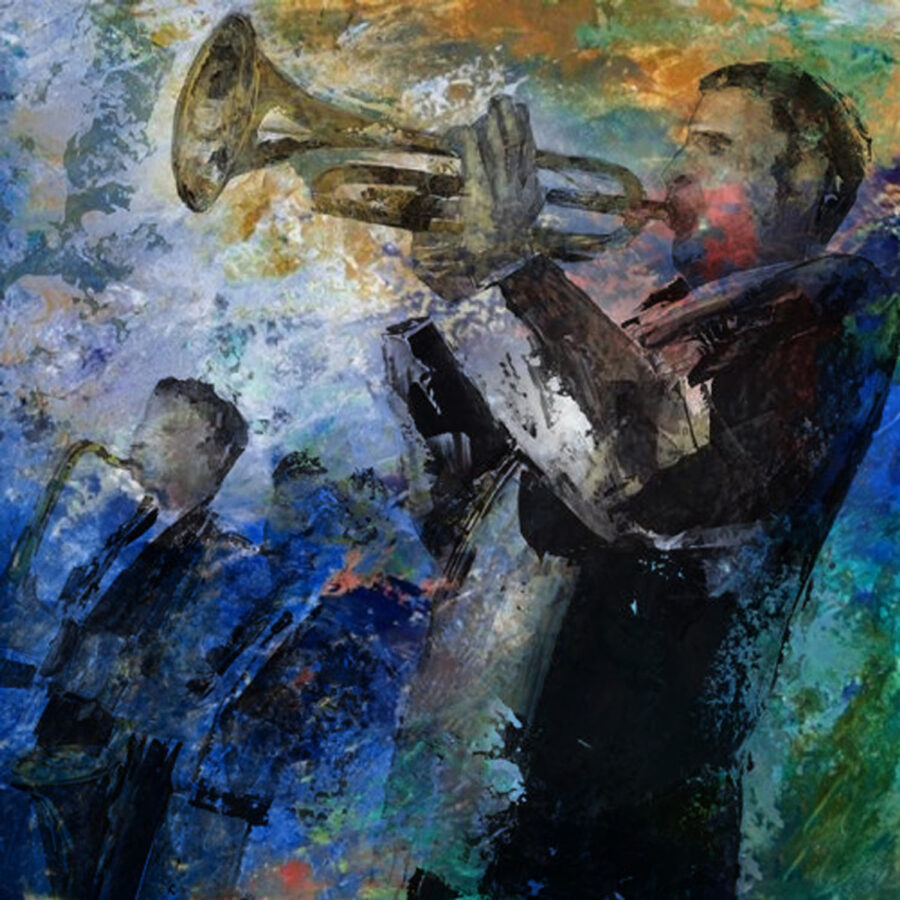Jazz music has long been a powerful source of inspiration for artists across various disciplines, especially within the realm of visual art. The emotive and spontaneous nature of jazz deeply influenced the Abstract Expressionist movement that emerged in the mid-20th century. This dynamic artistic movement, known for its emphasis on gestural brushwork, vibrant colors, and emotional intensity, mirrors the improvisational energy found in jazz. In this article, we explore the profound connection between jazz and Abstract Expressionism, focusing on iconic artists like Jackson Pollock, Willem de Kooning, and Mark Rothko, and how their work embodies the spirit of jazz.
The Birth of Abstract Expressionism, Jazz and the Art of Spontaneity
Abstract Expressionism came to life in the United States after World War II, during a period of social and political upheaval. Artists of this movement sought new ways of expressing their individual experiences, rejecting traditional artistic techniques in favor of abstraction and spontaneity. Jazz, with its roots in African American culture and its focus on improvisation, became a natural parallel for these artists.
Jazz’s emphasis on rhythm, freedom, and emotional expression mirrored the desires of Abstract Expressionist painters to break free from constraints and create art that was raw, instinctual, and deeply personal. The energetic and often chaotic nature of jazz offered a soundtrack that inspired artists to reflect the turbulent times through their vibrant and abstract works. Jazz provided not just musical inspiration, but also a philosophy of expression that shaped the foundation of the Abstract Expressionist movement.
Jackson Pollock, Dripping Jazz onto the Canvas
One of the most iconic figures in Abstract Expressionism, Jackson Pollock, is perhaps the most direct embodiment of the relationship between jazz and visual art. Pollock's famous drip paintings are a testament to the spontaneity and fluidity that jazz musicians express in their performances. Similar to a jazz improviser, Pollock engaged in instinctive, unpredictable movements, allowing the paint to flow freely and form layers of dynamic texture and color.
Each drip, splash, and gesture in Pollock's work can be likened to a musical note in a jazz composition. His canvases came alive with energy and movement, capturing the visceral excitement of a live jazz performance. Pollock’s ability to create such intricate and emotional works through uncontrolled motion echoes the improvisational spirit of jazz, solidifying his place as an artist deeply influenced by music.
Willem de Kooning, The Fusion of Chaos and Rhythm
Willem de Kooning, another key figure in Abstract Expressionism, drew on the rhythmic and unpredictable qualities of jazz to inform his own artistic style. Known for his aggressive brushstrokes and vibrant colors, de Kooning’s work shares many similarities with the improvisational nature of jazz. In his paintings, colors and shapes swirl together in a chaotic, yet rhythmically precise manner, akin to a jazz musician responding to the unpredictable shifts in a live performance.
De Kooning’s artistic process was spontaneous, much like a jazz soloist navigating through melodies and harmonies. His work captures the emotional intensity and unpredictability that jazz embodies, translating those elements into powerful visual compositions that convey an emotional charge, rooted in the fluidity and chaos of both painting and music.
Mark Rothko, The Emotional Palette of Jazz
Mark Rothko’s work in Abstract Expressionism is often associated with his iconic color field paintings, which are known for their simplicity and emotional depth. Rothko sought to evoke profound emotional responses from viewers through the use of large, bold swaths of color. His canvases, often enveloping the viewer, invite introspection and contemplation, much like the emotive depth found in jazz.
Rothko’s use of color as a vehicle for expression mirrors the emotional resonance of jazz melodies. Just as a jazz piece can elicit a range of emotions, from joy to melancholy, Rothko’s paintings provide a similar emotional journey, with colors that seem to pulse and vibrate, creating a visual rhythm that is deeply moving. The parallel between Rothko’s color fields and the improvisational jazz melodies of his time speaks to the enduring relationship between these two art forms.
Contemporary Echoes, The Continuing Influence of Jazz in Art
The influence of jazz on Abstract Expressionism is not confined to the past; it continues to resonate in contemporary art today. Many modern artists experiment with sound, using jazz music as a foundation for their work. Interactive installations that combine visual art with live jazz performances are becoming increasingly popular, reflecting a growing interest in the fusion of different artistic mediums.
These contemporary explorations demonstrate how the principles of improvisation and emotional depth found in jazz remain a vital source of inspiration for artists seeking to push the boundaries of creative expression. The integration of sound and visual art is expanding the possibilities for how art is experienced, creating multisensory experiences that deepen the emotional engagement of audiences.
A Legacy of Interdisciplinary Inspiration, Jazz’s Lasting Impact on the Arts
The dynamic relationship between jazz and visual art is a prime example of how interdisciplinary inspiration can foster creative innovation. The Abstract Expressionists drew upon jazz not just as a musical form, but as a philosophical framework that encouraged spontaneity, emotion, and freedom. Today’s artists continue to draw from this rich legacy, using jazz’s improvisational spirit to fuel their creative processes and connect with contemporary audiences.
As artists experiment with blending sound and visual mediums, they continue to honor the intersection of jazz and visual art. This ongoing dialogue between different art forms helps to redefine the creative process, inspiring future generations to think outside traditional boundaries and explore new ways of expressing themselves.
The Enduring Influence of Jazz on Modern Painting
The influence of jazz on Abstract Expressionism demonstrates the powerful connection between music and visual art. Through artists like Jackson Pollock, Willem de Kooning, and Mark Rothko, we see how jazz’s spontaneity, emotional depth, and improvisational nature shaped the development of modern painting. As artists continue to explore the intersections of sound and visual art, the legacy of jazz remains a transformative force, inspiring creativity and innovation across artistic disciplines. The enduring relationship between jazz and visual art serves as a testament to the power of cross-disciplinary influence and the infinite possibilities of artistic expression.









